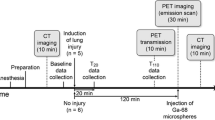Abstract
The objective of this study was to evaluate the feasibility and safety of lung volume reduction by transbronchial alcohol and lipiodol suspension infusion with the aid of balloon-tipped catheter occlusion. Twenty-six healthy adult rabbits were divided into four treatment groups: alcohol and lipiodol suspension infusion (n = 8), lipiodol infusion (n = 8), alcohol infusion (n = 5), or bronchial lumen occlusion (n = 5). After selective lobar or segmental bronchial catheterization using a balloon-tipped occlusion catheter, the corresponding drug infusion was performed. Bone cement was used to occlude the bronchial lumen in the occlusion group. The animals were followed up for 10 weeks by chest X-ray and computed tomography (CT), and then the whole lungs were harvested for histological examination. Alcohol and lipiodol suspension or lipiodol could be stably retained in alveoli in the first two groups based on chest X-ray and CT, but obvious collapse only occurred in the group receiving alcohol and lipiodol suspension or the bronchial lumen occlusion group. Histological examination revealed damage and disruption of the alveolar epithelium and fibrosis in related lung tissue in the group receiving alcohol and lipiodol suspension. Similar changes were seen in the bronchial lumen occlusion group, apart from obvious marginal emphysema of the target areas in two animals. Interstitial pneumonia and dilated alveoli existed in some tissue in target areas in the lipiodol group, in which pulmonary fibrosis obliterating alveoli also occurred. Chronic alveolitis and pleural adhesion in target areas occurred in the group infused with alcohol alone, whereas visceral pleura of the other three groups was regular and no pleural effusion or adhesion was found. Alcohol and lipiodol suspension that is stably retained in alveoli can result in significant lung volume reduction. Through alcohol and lipiodol suspension infusion, obstructive emphysema or pneumonia arising from bronchial lumen occlusion could be avoided.
Similar content being viewed by others
References
Cooper JD, Patterson GS, Sundaresan RS, et al. (1996) Results of 150 consecutive bilateral lung volume reduction procedures in patients with severe emphysema. J Thorac Cardiovasc Surg 112:1319–1329
Benditt JO, Lewis S, Wood DE, et al. (1997) Lung volume reduction surgery improves maximal O2 consumption, maximal minute ventilation, O2 pulse, and dead space to tidal volume ratio during leg ergometry. Am J Respir Crit Care Med 156:561–566
Moy ML, Ingenito EP, Mentzer SJ, et al. (1999) Health-related quality of life improves following pulmonary rehabilitation and lung volume reduction surgery. Chest 115:383–389
Criner GJ, Cordova SC, Furukawa S, et al. (1999) Prospective randomized trial comparing bilateral lung volume reduction surgery to pulmonary rehabilitation in severe chronic obstructive pulmonary disease. Am J Respir Crit Care Med 160:2021–2027
Geddes D, Davies M, Koyama H, et al. (2000) Effects of lung volume reduction in patients with severe emphysema. N Engl J Med 343:239–245
Goodnight-White S, Jones WJ, Baaklini J, et al. (2000) Prospective randomized controlled trial comparing bilateral lung volume reduction surgery (LVRS) to medical therapy alone in patients with emphysema. Chest 118:102
Pompeo E, Marino M, Nofroni J, et al. (2000) Reduction pneumoplasty versus respiratory rehabilitation alone in severe emphysema: a randomized study. Ann Thorac Surg 70:948–954
Snell G, Holworth L, Borrill ZL, et al. (2003) The potential for bronchoscopic lung volume reduction using bronchial prosthesis: a pilot study. Chest 124:1073–1080
Toma TP, Hopkinson NS, Hillier J, et al. (2003) Bronchoscopic volume reduction with valve implants in patients with severe emphysema. Lancet 361:931–933
Yim AP, Hwong TM, Lee TW, et al. (2004) Early results of endoscopic lung volume redution for emphysema. J Thorac Cardiovasc Surg 127:1564–1573
Gonzalez X, Dillard DH, Devore LJ, et al. (2002) Evaluation of bronchoscopic and surgical lung volume reduction as single or combined procedures. Chest 122(Ssuppl):192–193
Ingenito EP, Reilly JJ, Mentzer SJ, et al. (2001) Bronchoscopic volume reduction: A safe and effective alternative to surgical therapy for emphysema. Am J Respir Crit Care Med 2001;164:295–301
Ingenito EP, Berger RL, Henderson AC, et al. (2003) Bronchoscopic volume reduction using tissue engineering principles. Am J Respir Crit Care Med 167:771–778
Dong YH, Dong WH, Li HM, et al. (2004) Lung volume reduction by bronchial embolization in an animal model:a prelimimary report. Acad J Sec Mil Med Univ 25:985–988
Ke W, Gan WC, You YF, et al. (2005) Pathological observation of functional pulmonary lobectomy in canines. Chin J Med Imaging Technol 21:183–186
You YF, Gan WC,Yin WH, et al. (2005) Animal model establishment of functional pulmonary lobectomy. Chin J Intervent Imaging Ther 2:58–62
Chung MP, Monick MM, Hamzeh NY, et al. (2003) Role of repeated lung injury and genetic background in bleomycin-induced fibrosis. Am J Respir Cell Mol Biol 29:375–380
Szapiel SV, Elson NA, Fulmer JD (1979) Bleomycin-induced interstial pulmonary disease in the nude,anthymic mouse. Am Rer Respir Dis 120:893
Wang WS, Yao J, Wang WQ, et al. (2005) Experimental study on lung volume reduction by bronchial embolization with lipiodol emulsion. Acta Univ Med Anhui 40:528–531
Toma TP, Matsuo K, Tamaoki A, et al. (2002) Endoscopic bronchial occlusion with spigots in patients with emphysema. Am J Respir Crit Care Med 165(Suppl.):B9
Author information
Authors and Affiliations
Corresponding authors
Rights and permissions
About this article
Cite this article
Wang, W., Dong, Y., Liu, B. et al. A Pilot Study on the Feasibility of Interventional Lung Volume Reduction. Cardiovasc Intervent Radiol 31, 177–182 (2008). https://doi.org/10.1007/s00270-006-0211-8
Published:
Issue Date:
DOI: https://doi.org/10.1007/s00270-006-0211-8




